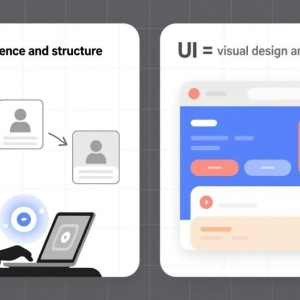When people think about web design, they often focus on the visual appeal—bold colors, clean layouts, or elegant fonts. These elements are essential for grabbing attention, but they’re only part of the picture. The true power of a website lies in its information architecture (IA), the structure that organizes content and guides users through their journey.
A stunning design might draw visitors in, but without a clear structure, they’ll quickly get frustrated and leave. Information architecture is what makes a website intuitive and effective, ensuring users find what they need without effort. A web design agency that excels in IA creates sites that are as functional as they are visually appealing.
What Is Information Architecture?
Information architecture is the process of organizing a website’s content to make navigation seamless. It involves arranging pages, labeling sections, and creating logical pathways so users can move through the site effortlessly.
Picture a museum. You can have stunning exhibits and elegant signage, but if the layout is confusing or the paths are unclear, visitors will struggle to find their way. A website operates similarly. A web design agency builds IA by planning how pages connect, what information takes priority, and how users flow from one section to another.
IA addresses critical questions:
- What should users see first?
- How do they find the next piece of information?
- How can they navigate back easily?
Without clear answers, even the most polished design won’t keep users engaged.
Why Businesses Ignore IA
Many businesses prioritize visuals when choosing a web design agency because they’re easier to evaluate. Eye-catching mockups, trendy animations, and vibrant color schemes stand out in a portfolio. But focusing solely on aesthetics misses the bigger picture.
A well-structured website saves users time and builds confidence in your brand. A disorganized one, no matter how attractive, frustrates visitors and drives them away. A web design agency skilled in IA blends design and structure, using visuals to support the flow of information rather than overshadowing it.
The Cost of Poor IA
A website with weak information architecture might look fine initially. Pages load, menus are visible, and the design is professional. But small issues create big problems. Users encounter dead-end pages, struggle to find key details, or get confused by inconsistent navigation. A “Contact” page might be hidden under a vague “Resources” tab, or a product description could be buried several clicks deep.
These frustrations lead to lost opportunities. Visitors abandon the site. Search engines struggle to crawl it, hurting your SEO performance. Conversions drop, and businesses often mistake this for a marketing issue when it’s really a structural flaw. A web design agency with IA expertise can prevent these problems by creating a clear, user-focused framework.
What Great IA Feels Like
When information architecture is executed well, users don’t notice it—they just feel it. Navigation feels natural, like the site was designed with their needs in mind. They always know where they are, where they’ve been, and where to go next.
This doesn’t require complex menus or endless links. Often, it’s about simplicity—fewer, clearer choices. For instance, a restaurant’s site might make the menu a single click away, or a tech company’s site might group services by user needs rather than technical terms. A web design agency that masters IA creates experiences that feel effortless and respectful of users’ time.
How IA Is Crafted
Building information architecture starts before any design work begins. A web design agency maps out the site’s content—every page, its purpose, and how it connects to others. This might involve creating a sitemap or grouping content into categories like “About,” “Products,” or “Blog.”
The process is about understanding the user. The agency asks: What are visitors searching for? What might trip them up? How can we streamline their experience? The result is a site that feels intuitive, as if it anticipates the user’s next move.
The SEO Link
Information architecture isn’t just for users—it’s critical for search engines too. Google crawls a site by following its links and structure. If pages are poorly connected or labeled ambiguously, search engines may struggle to index them, lowering your rankings. A web design agency that integrates IA with SEO ensures your site is optimized for both humans and algorithms.
Even a robust SEO strategy will fall short if the site’s structure is weak. Good IA lays the foundation for better rankings and user satisfaction.
Building Brand Trust
IA does more than guide navigation—it shapes how users perceive your brand. A clear, organized site suggests a company that’s professional and reliable. A confusing or cluttered site, even with great products, can make your business seem disorganized.
This is crucial for businesses working with a web design agency, especially on a budget. A simple, well-structured site can outperform a flashy, poorly organized one. IA builds trust and drives engagement, setting the stage for conversions.
Looking Past the Homepage
Many businesses obsess over their homepage, treating it as the star of the show. But most visitors don’t stay there long—they move to product pages, FAQs, or contact forms where decisions happen. If these pages are hard to find, the homepage’s polish is wasted.
A web design agency with strong IA skills treats the entire site as a unified system. Each page is designed to stand alone while guiding users forward, creating a cohesive experience from start to finish.
The Lasting Benefits
A website with robust information architecture is built for the future. It’s easy to update and scales as your business grows. Adding a new product or service? A strong structure accommodates it seamlessly. It also streamlines collaboration—marketers, developers, and content creators know where new content belongs.
A web design agency that prioritizes IA delivers a site that evolves with your business, saving you from costly redesigns later.
Closing Thoughts
A website’s success isn’t just about its appearance—it’s about how it functions. Design catches the eye, but information architecture keeps users engaged. It’s the invisible framework that makes navigation seamless and content accessible.
When partnering with a web design agency, don’t just focus on aesthetics. Ask how they’ll structure your site to ensure it’s intuitive and effective. A great website isn’t just a collection of pages—it’s a system that guides users, builds trust, and drives results.











